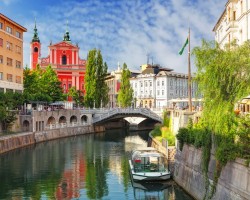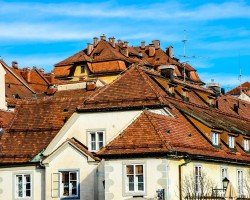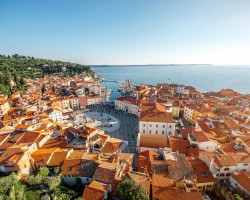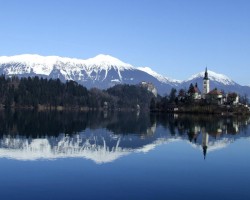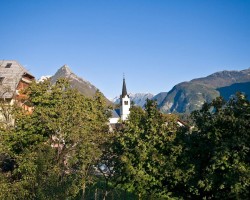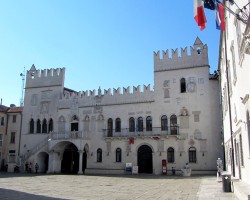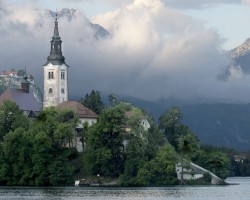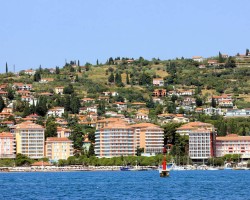Best time to go to Slovenia for a perfect weather and where to go?
When is the best time to go to Slovenia?
From a weather perspective, the best time to visit Slovenia is between June and September. However, the country also has a lot to offer travelers at other times of the year! The choice of your vacation dates will therefore mainly depend on the experiences you wish to have on-site.
- For a trip to Ljubljana, the capital, choose July or August if you want to be at the heart of the action. This is when the streets are liveliest, and the weather allows you to truly enjoy the terraces and various parks the city has to offer. If you prefer more tranquility, June or September are a good idea. The weather is nice, there are fewer tourists, and hotel prices are lower.
- For hiking, for example in Triglav National Park or along the Via Alpina, it is better to go between May and September, although in spring, the risk of rain is higher. By the end of September, nature takes on beautiful autumn colors. If you don't mind the cold, you can even extend your trip into October if you are well equipped.
- For a beach holiday on the Adriatic coast, the best time to go to Slovenia is between June and September. The sea water then reaches idyllic temperatures, around 27-28 degrees. However, in July and August, the coast is very crowded, especially since it is only 47 km long! Expect crowded beaches and accommodation prices to be high.
- For a trip focused on wildlife and flora, the ideal time to visit Slovenia is between March and May. The fields and mountains are adorned with a multitude of flowers of all colors, and this is the time of year when animals are most visible. You may see deer, chamois, and even bears if you are lucky!
- Throughout the year, and even if the weather is not great, you can relax in Slovenian spas. The program includes soothing treatments, massages, and hot baths! On rainy days, you can also take refuge in the many caves the country has. Regardless of the outside temperature, it remains around 10 degrees inside. However, the atmosphere is always very humid, so be sure to bring waterproof clothing.
- For winter sports, prioritize the period from December to March. Snow falls abundantly, and all conditions are met for an unforgettable stay! The most well-known and largest resort is located in Kranjska Gora, but the Slovenian mountains are full of smaller, more family-friendly resorts.
When to visit Slovenia if you prefer to avoid the crowds? The best compromise is to go in April or October. Admittedly, the weather conditions are not always perfect, but most of the time the sun is shining, offering visitors beautiful days during which it is possible to explore the country in peace.
Annual weather in Slovenia
For information about the climate and the weather city by city in Slovenia for a specific month, click on the corresponding line below:
| Month | Our opinion | View Details | |||
|---|---|---|---|---|---|
| January | 27°F to 47°F | very bad weather | |||
| February | 27°F to 49°F | very bad weather | |||
| March | 32°F to 56°F | very bad weather | |||
| April | 43°F to 65°F | tolerable weather* | |||
| May | 50°F to 70°F | tolerable weather* | |||
| June | 59°F to 81°F | good weather* | |||
| July | 63°F to 85°F | good weather* | |||
| August | 61°F to 85°F | good weather | |||
| September | 52°F to 76°F | good weather | |||
| October | 43°F to 67°F | tolerable weather* | |||
| November | 38°F to 58°F | very bad weather* | |||
| December | 31°F to 49°F | very bad weather |
Best time to travel to Slovenia by cities
Climate and Weather in Slovenia
The climate of Slovenia consists of 2 main types:
- An oceanic climate with a temperate summer is largely predominant as it covers 83% of the country, particularly in the capital, Ljubljana.
- A subarctic climate with cold winters prevails in the high mountains of Slovenia, especially in the Kranjska Gora region, not far from the Austrian border.
- Much more rarely, a humid subtropical climate with no dry season and a warm summer can be found near Kostabona, as well as a humid continental climate with a temperate summer and no dry season towards Prevalje.
These different climates are explained by the geography of the country. Indeed, Slovenia is a Central European country bordered by the Adriatic Sea, Italy, Austria, Hungary, and Croatia. It has a varied terrain present almost everywhere and the Slovenian Alps rise to over 2800 meters in altitude.
In general, the weather in Slovenia is characterized by large temperature differences between the seasons. The higher you go in altitude, the lower the temperatures become and the more precipitation increases. The wind can also blow strongly throughout the country, particularly the bora, which comes from the northeast between December and April, bringing with it cold and dry air.
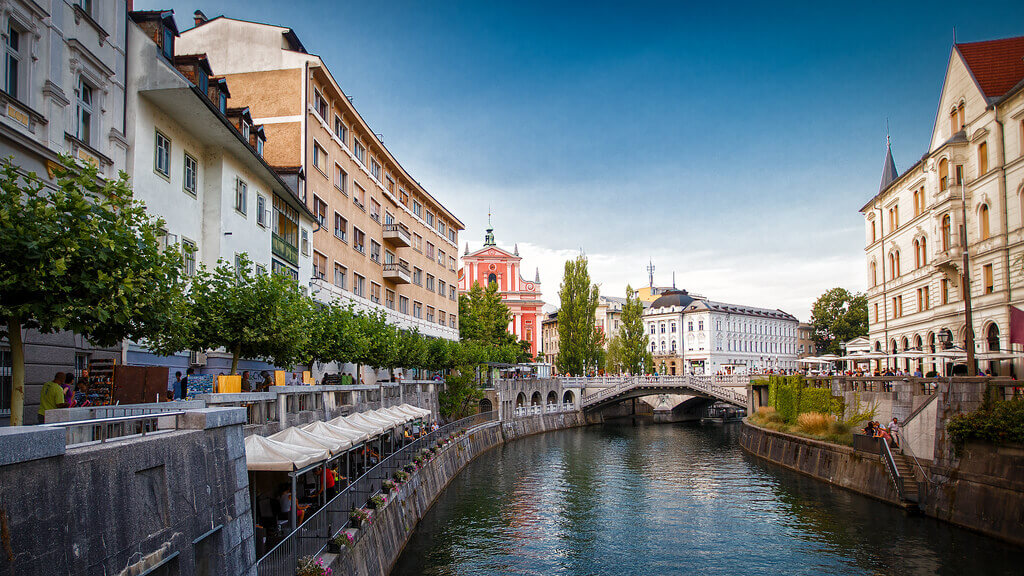
Climate in Slovenia in Summer
Overall, summer is a warm and pleasant time in Slovenia. There are some variations depending on the months and regions:
- From late June to late August, temperatures range between 26 and 29°C (85°F) . It is along the coast, near Piran, that the temperatures are the highest. This is also the best time to enjoy the sea, with water temperatures around 27 to 28°C (83°F) . Rainfall is present throughout the season, mostly in the form of thunderstorms, but this will not spoil your trip. It is in the eastern part of the country, in the Maribor region, that rain is most frequent, especially in July.
- In September, temperatures drop by 5 to 6 degrees across the country, ranging between 21 and 24°C (76°F) . The late season remains very pleasant, particularly along the Adriatic coast, where the sea water is warmer than the air (about 27°C (81°F) ).
If you go to the alpine regions, be aware that the atmosphere is cooler due to the altitude. Thunderstorms are also more frequent, although this period is the most suitable for a stay.
Climate in Slovenia in Autumn
Autumn is short as it only lasts from late September to late October. While the weather is still favorable on the coast with maximum temperatures around 20°C (68°F) , the rest of the country cools down quickly, showing averages close to 15°C (59°F) , and even much less in the Alps where snow falls regularly. However, rainfall is less frequent than during the summer season, and the sun is mostly present, providing a welcome feeling of warmth.
In November, winter seems to be settling in already, and temperatures drop significantly. For example, it is around 10°C (50°F) during the day in Maribor and Ljubljana and between 3 and 5°C (41°F) at night. Snowfall is therefore frequent, as is rain in the plains. Only the coast is still spared, with maximum temperatures nearing 15°C (59°F) , although the atmosphere is more humid.
In December, the climate is very unfavorable throughout Slovenia. Daytime temperatures range between 5 and 9°C (49°F) , with the coast being slightly more spared. At night, minimum temperatures are negative in the Maribor region and close to 0°C (32°F) elsewhere. Snowfall becomes more frequent and abundant, thus opening the ski season in the mountains.
Climate in Slovenia in Winter
In winter, from late December to late March, snow falls across the entire country, and temperatures are cold:
- From late December to late February, daytime temperatures range between 3 and 6°C (43°F) , but the thermometer drops at night, showing minimums that are mostly negative, between -1 and -3°C. On the coast, it is milder, around 8-9°C during the day and 1-2°C at night, but the region is not spared from the wind, which enhances the feeling of coolness.
- In March, the mercury rises by about 5°C (41°F) , and snowfall decreases, but winter is still in full swing, especially in the higher altitudes.
Climate in Slovenia in Spring
Between late March and late June, spring is marked by the gradual melting of snow, a warming of temperatures, and frequent rain:
- In April, it starts to feel nice during the day with maximums around 17 degrees. However, it is still cool at night, with temperatures rarely exceeding 10°C (50°F) . It still snows regularly at higher altitudes, while the coast enjoys very pleasant spring weather.
- In May, only the Ljubljana region is suitable for a stay with averages around 20°C (68°F) during the day. Elsewhere, although the thermometer is equally mild, rain is very present.
- In June, temperatures begin to be summery, ranging between 24 and 26°C (79°F) during the day and 18 to 20°C (68°F) at night, allowing for full enjoyment of long evenings on the terrace! The only downside: rain, which is still very present in the eastern part of the country. It is also not uncommon to still find snow on the highest peaks.
Temperatures and rainfall in Slovenia
On these 3 graphs, we present the evolution of temperatures of Slovenia and month-by-month rainfall for the cities of Ljubljana, Maribor, Piran, Ankaran and Bled, as well as the month-by-month sea temperature for coastal cities.
Peak visitor numbers and tourist seasons in Slovenia
Find out when Slovenia has its high tourist season (the period when the influx of tourists is highest) and off-peak tourist season using our data and figures.
Tourist seasons in Slovenia
The months with low numbers of tourists are: January, February, March, April, October, November and December. The number of visitors to Slovenia is high in: May, June, July, August and September.
- Very low season in Slovenia: January, February, March and November.
- Low season in Slovenia: April, October and December.
- High season in Slovenia: May, June, July and September.
- Peak season in Slovenia: August.
Figure: Visitor index for Slovenia month by month
Average price for flights to Slovenia
A return flight between London and Ljubljana is generally cheaper if you go in january ($ 172 on average): this is the best time for travellers on a tight budget. In contrast, you may end up paying $ 179 more for your airline ticket to Ljubljana if you go in august.
Find the best price for your flight Flight prices to Slovenia
Where to go in Slovenia?
This table allows you to see the maximum temperature for each city and our opinion on the weather month by month (see colour legend below the table).
| Cities | jan. | feb. | mar. | apr. | may | jun. | jul. | aug. | sep. | oct. | nov. | dec. |
| Ljubljana | 38°F | 41°F | 50°F | 61°F | 68°F | 77°F | 81°F | 81°F | 70°F | 59°F | 50°F | 41°F |
| Maribor | 40°F | 43°F | 52°F | 63°F | 68°F | 76°F | 79°F | 81°F | 72°F | 61°F | 52°F | 43°F |
| Piran | 47°F | 49°F | 56°F | 63°F | 70°F | 79°F | 83°F | 85°F | 76°F | 67°F | 58°F | 49°F |
| Ankaran | 47°F | 49°F | 56°F | 63°F | 70°F | 79°F | 83°F | 85°F | 76°F | 67°F | 58°F | 49°F |
| Bled | 36°F | 38°F | 47°F | 56°F | 63°F | 72°F | 76°F | 76°F | 67°F | 56°F | 47°F | 40°F |
| Bohinj Lake (Bohinjsko jezero) | 36°F | 38°F | 47°F | 56°F | 63°F | 72°F | 76°F | 76°F | 67°F | 58°F | 47°F | 40°F |
| Bovec | 38°F | 41°F | 49°F | 58°F | 65°F | 74°F | 77°F | 77°F | 68°F | 59°F | 49°F | 41°F |
| Izola | 47°F | 49°F | 56°F | 63°F | 70°F | 79°F | 83°F | 85°F | 76°F | 67°F | 58°F | 49°F |
| Jezersko | 40°F | 41°F | 50°F | 61°F | 68°F | 77°F | 81°F | 81°F | 70°F | 61°F | 50°F | 41°F |
| Koper | 47°F | 49°F | 56°F | 63°F | 70°F | 79°F | 83°F | 85°F | 76°F | 67°F | 58°F | 49°F |
| Kostabona | 47°F | 49°F | 56°F | 63°F | 70°F | 79°F | 83°F | 85°F | 76°F | 67°F | 58°F | 49°F |
| Kozjanski park (Kozjansko Regional Park) | 40°F | 41°F | 52°F | 61°F | 68°F | 76°F | 79°F | 81°F | 70°F | 61°F | 50°F | 41°F |
| Kranjska Gora | 36°F | 38°F | 47°F | 56°F | 63°F | 72°F | 76°F | 76°F | 67°F | 56°F | 47°F | 40°F |
| Mojstrana | 36°F | 38°F | 47°F | 56°F | 63°F | 72°F | 76°F | 76°F | 67°F | 56°F | 47°F | 40°F |
| Olimje | 40°F | 41°F | 52°F | 61°F | 68°F | 76°F | 79°F | 81°F | 70°F | 61°F | 50°F | 41°F |
| Portorož | 47°F | 49°F | 56°F | 63°F | 70°F | 79°F | 83°F | 85°F | 76°F | 67°F | 58°F | 49°F |
| Predjama | 40°F | 41°F | 50°F | 59°F | 67°F | 76°F | 79°F | 81°F | 70°F | 59°F | 50°F | 43°F |
| Škofja Loka | 38°F | 41°F | 50°F | 61°F | 68°F | 77°F | 81°F | 81°F | 70°F | 59°F | 50°F | 40°F |
| Solcava | 40°F | 41°F | 50°F | 61°F | 68°F | 77°F | 81°F | 81°F | 70°F | 61°F | 50°F | 41°F |
| Stanjel | 47°F | 49°F | 54°F | 63°F | 68°F | 77°F | 83°F | 85°F | 76°F | 65°F | 56°F | 49°F |
Legend:
good weather
tolerable weather
bad weather
very bad weather
About Slovenia
What can I do in Slovenia?
Beaches / swimming
Nature and countryside
Culture and heritage
Sports
Family travel
Crafts / shopping
Gastronomy
Nightlife
Is this weather information for Slovenia reliable?
Climate data for Slovenia has been gathered every day since January 2009. The analysis of these meteorological data for Slovenia allows us to determine the average for each month in Ljubljana, Maribor, Piran, Ankaran, Bled, Bohinj Lake (Bohinjsko jezero), Bovec, Izola, and 39 other cities.
So yes: this data is reliable except in cases of temporary climate disruption in the region.

